Friday, November 16 2012
We have received several emails from our subscribers asking how a model like MIPS3/MF, which trades an average of 15 times/year, can issue 2-3 trade signals in one week.,
The happens because:
1) the 15 trades/year for MIPS3/MF is an “average”, which means in some years it can trade
only 9 times (like in 2009) and in other years it may trade as many as 24 times (like in 2011), and
2) in any time frame, MIPS can trade 2-3 times in one month, and only one time in 3-5 months
(like at the end of 2010).
The main reason for this is the MIPS models have multiple “stop-gap” and “safe-guard” measures built in that “test” the integrity and accuracy of each and every signal. Specifically, for a few days after every trade, MIPS checks to see if the recent signal really is on the right track. These stop-gaps and safe-guards are NOT simply “stops” as we know them, but are proprietary algorithms that check to see if the SPY is following the expected price/volume pattern predicted by the algorithms in the recent signal.
Normally, the MIPS models issue new signals based on many indicators/algorithms that believe that they have found a directional change in the market, like an “Inflection Point” or a “Key Reversal”, etc. When MIPS issues a signal based on the consensus of these algorithms, it then spends the next few days verifying the “expected outcome”. If the “expected outcome” is not met, MIPS will either (a) reverse its position or (b) get out entirely (i.e., go to cash).
See the example below for Inflection Points
Click here for animated example =>
http://en.wikipedia.org/wiki/File:Graph_of_sliding_derivative_line.gif

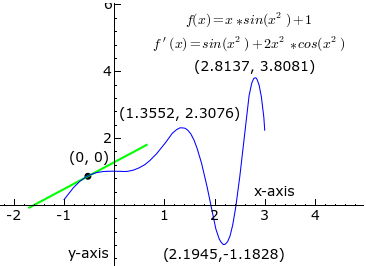
In this graphic animated presentation from Wikipedia above, imagine that the curved blue line is the price of the SPY and the traveling lines are the “slope” of this price curve at any point on the curve. Therefore,
1) when the slope is pointed up, the SPY is in an upward pattern, and
2) when the slope is pointed down (red line), the SPY is in a downward pattern, and
3) when the slope is flat or zero (black line), the SPY is in a flat or sideways pattern, and
is signaling the potential of having reached an “Inflection Point”.
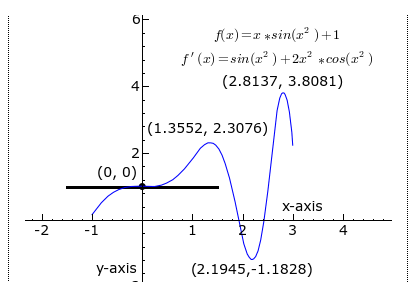
In the Wikipedia example above, at first the SPY is going up and the slope is pointing up (green up-line). When the slope turns flat/zero like it does near the Y-axis (black flat line), MIPS is looking for a change in direction in the SPY price from up to down (Inflection Point), and could signal a short signal. If the slope stays flat for a while or if the slope turns back up instead of turning down, MIPS could reverse its short signal and either (a) go long, or (b) go to cash. If MIPS does issue a cash signal and the slope then continues back up from there (as in the Wikipedia example as it crosses the Y-axis), MIPS will ultimately go long again. Over time, MIPS will go through tough periods trying to find a new trend and goes through 3-4 trades of –3% to +3%, but MIPS will ultimately find an intermediate trend (up or down) that will make us +10 to +15%, and the cycle repeats.
These “safety” algorithms above result in:
1) Negative - a few more trades than normal, and
2) Positive - greatly reduced losses on incorrect signals.
This can be seen in the MIPS long-term trading results below:
Winning/Losing Trades Average Gain/Loss
Winning Trades = 65% +3.0% Avg Gain/Trade
Losing Trades = 35% - 1.1% Avg Loss/Trade
After 100 trades, the win/loss ratio above equates to 195% up (65 x 3%) and 38.5% down (35 x 1.1), or 156% up (not compounded). Compounded, this would be in the range of 250% up (or more). And this happened in a market that was up only about 1% after 8 years and 100 MIPS trades.
We are not certain how many timing models have built in stop-gaps and safe-guards like MIPS, but we know a very large number of them that don’t.
Friday, November 16 2012
MIPS Members:
The SPY decisively broke its 200-day EMA on Wednesday, and the DIA and QQQ have been trading below their 200-day EMAs for the last 7-8 trading days. Thus far, of course, the market has not shown any signs of a rebound (see graph immediately below). All MIPS models have been short since late October, so let's keep our eyes and ears on government action regarding the "Fiscal Cliff". Remember, just a little good news can send an oversold market like this one straight up, if even for a short period of time and a "small" rally. And, don't forget about the Santa Claus rally the we wait for each year. With all of this to assimilate, we need to rely on new signals from the MIPS models for future guidance.
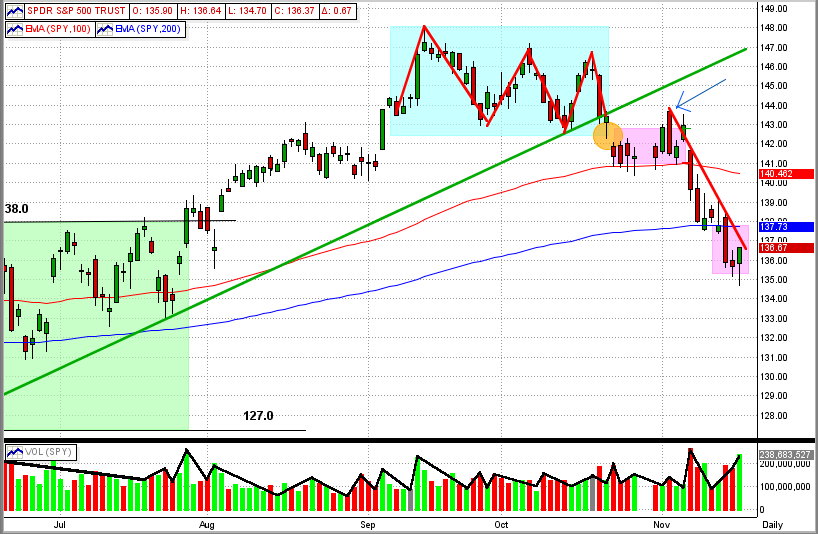
Monday, November 12 2012
This market pullback is scary all right, but is it leading into a full-out bear market ?
- First, let's take a look at how markets normally behave heading into a bear market.
For a bear market to occur, it is usually preceded by most of the following:
1) a 3-6 year bull market,
2) bad news raises its ugly head (economic, political, etc.),
3) the market begins to react negatively to the bad news,
4) we see "topping" behavior in recent market moves,
5) a correction that breaks several important long-term resistance levels occurs,
6) an uptick that challenges some previous downside resistance levels occurs somewhere along the way,
7) a "free fall" begins, and
8) if the "free fall" is widespread (SPY, DIA, QQQ, small/large cap, across sectors, etc), it turns into a secular
bear market.
So, how has the market (as measured by the S&P 500 ETF, SPY) performed according to the above ?
(please refer to the graphs below)
1) we have had a bull market since March 2009 (S&P 500 up over 120%),
2) the economic/political news from all over the world (including the USA) couldn't be much worse,
3) the SPY is down almost 10% from its mid-September high,
4) the SPY (and the DIA and QQQ) have all formed either a triple top or a head-and-shoulders top (red triangles),
5) this last drop had broken the SPY's 6-month up trendline (green line) , its head-and-shoulder's
neckline (black line), its 100-day EMA (red line), and its 200-day EMA (blue line)
- the orange ellipse shows down "gaps"
6) after it broke the neckline, the SPY made a kick up to test that resistance level (blue arrow),
7) we are NOT technically in a "free fall" yet, but the future does not look good, and
8) the SPY barely broke its 200-day EMA and has only been there for one day, but the DIA and QQQ have
experienced very definitive 200-day EMA breaches (shown by the purple ellipses in the graphs).
Technical analysis would lead us to believe that we are on the verge of a serious downturn, but just the slightest good news (like our executive and legislative branches getting things done for our country instead of staying in gridlock for their own personal gains), could change that in a heartbeat. Thankfully, MIPS is much better equipped than us to make long/short decisions in this environment. Besides that, a mechanical mathematical system like MIPS is not too proud or too stubborn to admit a mistake and reverse its decision if it has made an incorrect call (as opposed to human behavior). So, as usual, let's wait for MIPS to tell us what to do next. BTW, all MIPS models are short now.
PS - Take a look at the 4th graph below (labeled 2007) to see how the market was unfolding in 2007.
See any similarities ?
SPY
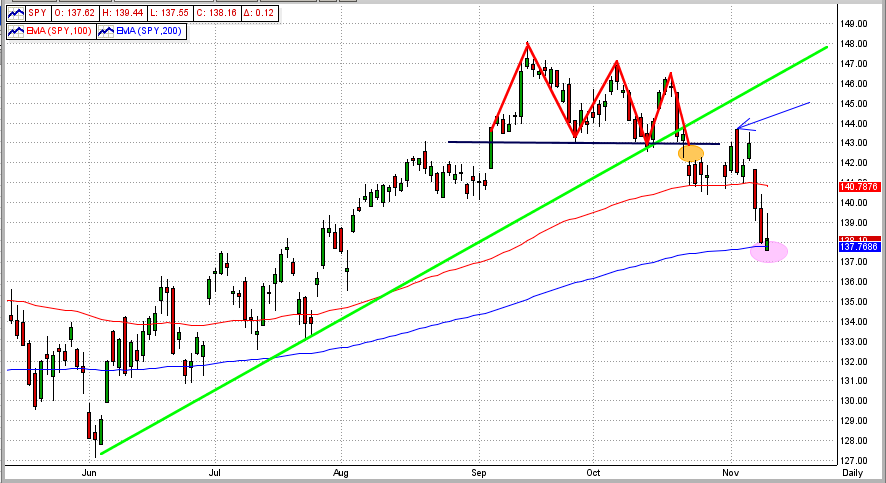 DIA
DIA
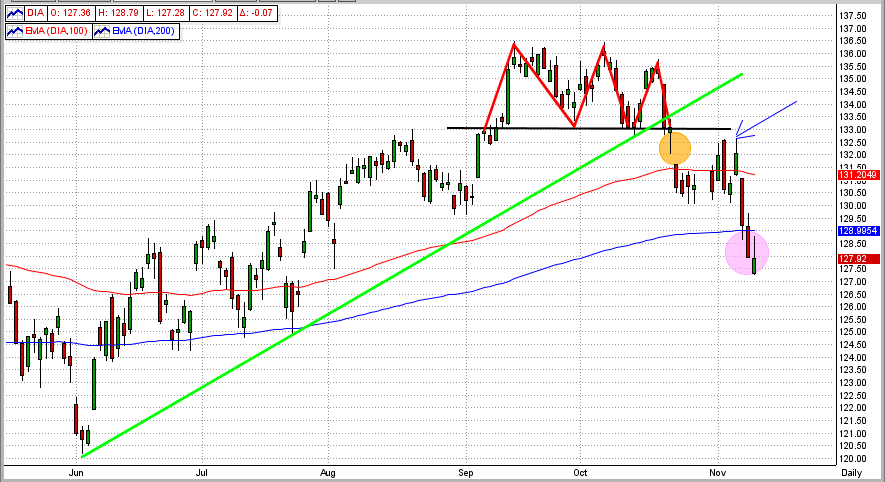
QQQ
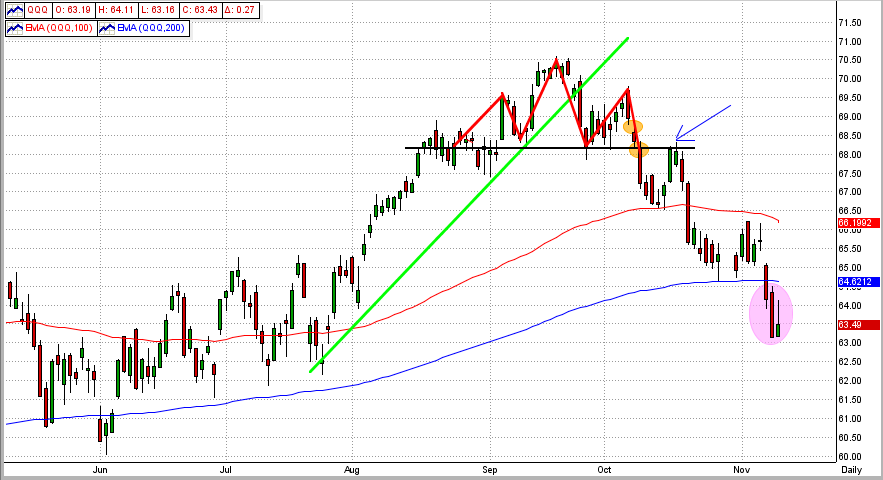
2007
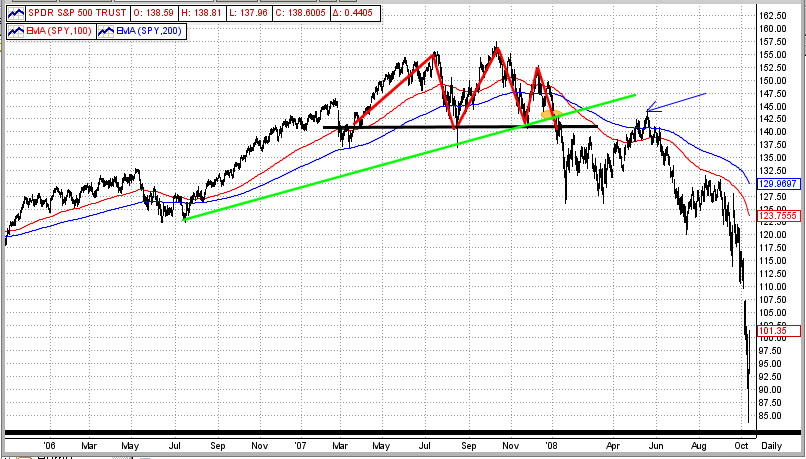
Tuesday, November 06 2012
There is a lot going on in the world these days, the most important of which is tonight's election. There are many possibilities that will follow who wins the election, but that is outside of the scope of the MIPS "commentary" emails.
However, there is one point that we would like to make regarding recent market action. For the last eight days, the market has traded in what we would call "No-Man's-Land" (see graph below). In the last 8-day period (orange box), the SPY has closed between its 50-day EMA on the upside (green line) and its 100-day EMA on the downside (red line). Last Friday, the SPY opened above its 50-day EMA, but fell back into this trading range by the close. Today, however, the SPY closed decisively above its 50-day EMA.
So, the question is: "Does this breakout of the recent trading range mean there is more upside coming or is it just another so-called "bull trap", which sucks the bulls back into long positions only to turn right back to the downside. Of course, no one really knows the answer to this (not enough info), and we will just have to wait and see.
Or, does MIPS see this breakout as a new "Inflection Point" (from down-to-up) ? The answer is "not yet", so again we will just have to wait for MIPS to tell us what to do next, and when.
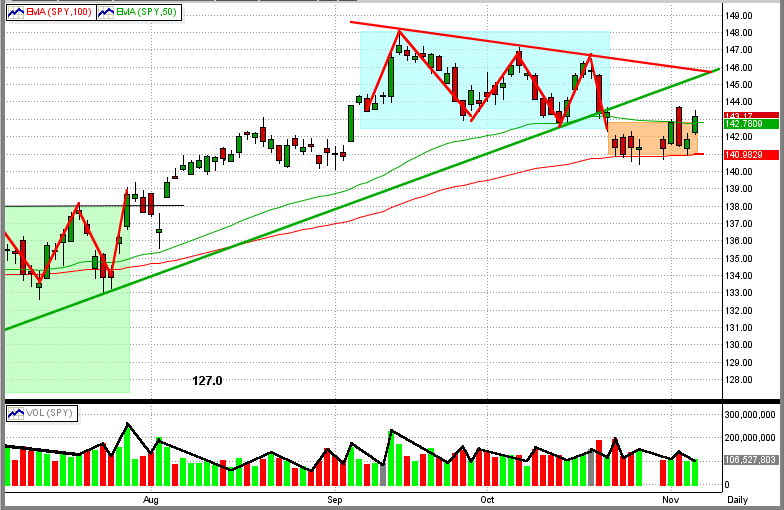
Friday, October 26 2012
The market has fallen to another critical level.
After falling about 4% in four trading days, the SPY has spent the last three days traveling along the "100-day EMA road" for the last three days (see Graph #1 immediately below). This is a critical point in the market because:
1) to get there, the SPY had to break resistance at $143.8 and 142.0 (i.e., the revered 1420 in the S&P 500).
2) the SPY is right on the very top of its 100-day EMA (red line),
3) we have seen bad 3rd quarter profit/outlook from some of the most stable companies in the counrty,
4) with bad profit and outlook numbers from tech leaders (Amazon, Apple, etc) after hours on Thursday, the
futures are down so we can expect a lower opening on Friday,
5) with any more bad economic/earnings data in the US, or bad news from Europe or China, this downdraft
could pick up steam quickly, and
6) these are very turbulent times and conditions/sentiment can change quickly.
All of the MIPS models (except the very low frequency MIPS1/VLF model) are short at this time. To get a better feeling of how MIPS "sees" the strength (or weakness) of this market, take a look at Graph #2 below.
Graph #1
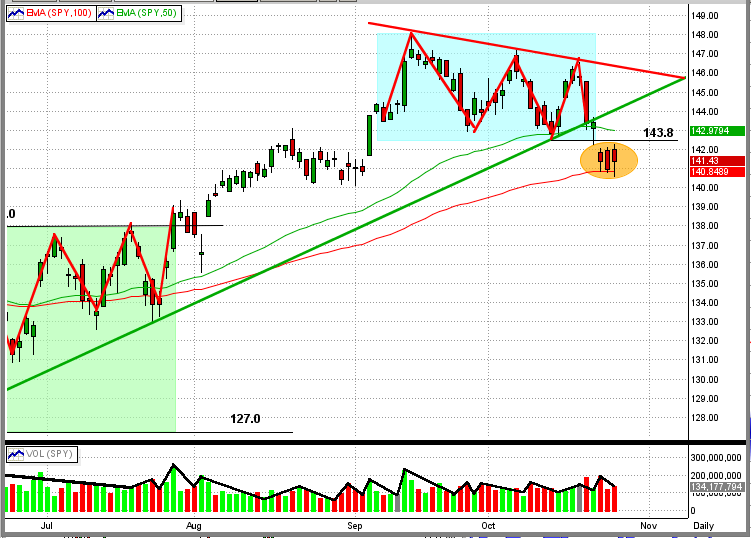
Graph #2
This graph shows the MIPS Strength Indicator (MSI) for the SPY. The MSI is a measure of the "strengh" of the market
trend as determined by the leading indicators in our MIPS models. You can see this graph about 1/3 down on the homepage of our website. The MSI graph is updated on our website at least once a week. CAUTION: The MSI is a measure of the strength of the market, but is NOT to be seen as or used as a "signal" indicator !!!

Monday, October 15 2012
It looks like we dodged a bullet today. From our last look at the SPY price/volume chart in our previous email, it looked as though we could be about to experience a serious downdraft. But, MIPS kept us LONG, and we are glad it did.
Today, the SPY hit a very critical downside price point and bounced back to the upside (see graph below).
At a price of $143 per share (black line), the SPY encountered the following resistance levels:
1) the 50-day EMA (green line),
2) the intermediate term trendline (blue line), and
3) the bottom of its six weeks trading range (cyan box).
Needless to say, it did not breach any of these resistance levels (which should prove to be very positive).
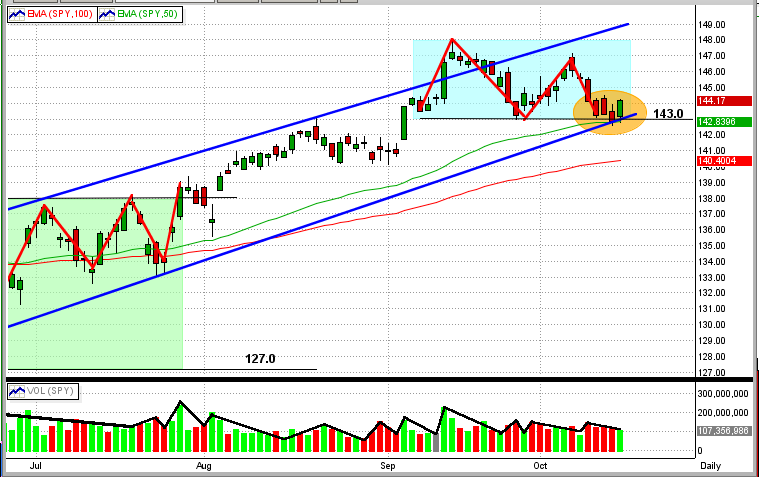
Saturday, August 04 2012
As suggested in our previous post, the market appears to be in a slow growing up-trend.
See the new graph immediately below. From this, you can see that:
1) The SPY has broken out of its prior trading range (green rectangle) to the up-side
2) The up-channel is readily apparent (black lines)
3) Since mid-year, the market is moving with precision to higher-highs and higher-lows
4) The SPY is above both of its 100-day and 200-day EMAs
5) In the last two swings, the SPY volume has been increasing in up markets and dropping in down markets
Let's enjoy this up-trend while it lasts. We expect a high level of upside resistance for the SPY between $141-142/share.
- if the SPY breaks this resistance to the upside, its next big resistance levels are between about $145-150/share
- at this time, we are about 13% below the 2000 and 2007 highs (approx. $157/share)
- this would be a good goal to attain, but it would also make an ideal point for the big guys to start selling big time.
If, or when, the market turns down (as it probably should), MIPS will get us to a cash or short position in ample time.
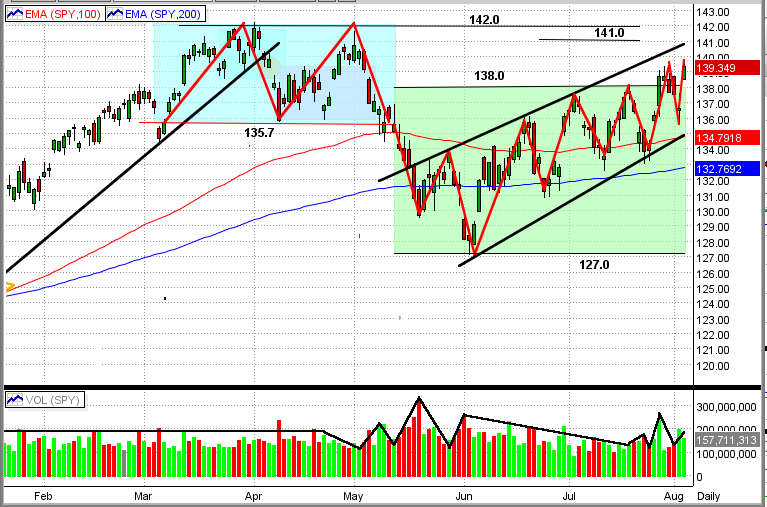
Monday, July 16 2012
Two weeks ago (7/2/12) we posted the below entitled "MIPS - Yet Another Trading Range or A New Up-Channel ???"
- the question was basically what kind of "pattern" the market was trading in?
Since then, the market seemed to have answered that question (see the graph immediately below). With higher highs and higher lows over the last 8-9 weeks, the market seems to be in a new "up-channel". If the SPY breaks above $136.20/share in the next few days, the next upside resistance levels will be at about $139, and then at $142/share (about +5% above today's close). It is a little bothersome that the trading volume is still declining when the market is rising. That tells me that it is NOT the big guys that are pushing the market up at this time. But, the little guys still have lots of buying power on the sidelines (i.e., money that is NOT in equities).
As of today's date, all MIPS models are Long (see Current Signals under the "Signals" tab on our homepage). MIPS will guide us in the right direction over time.
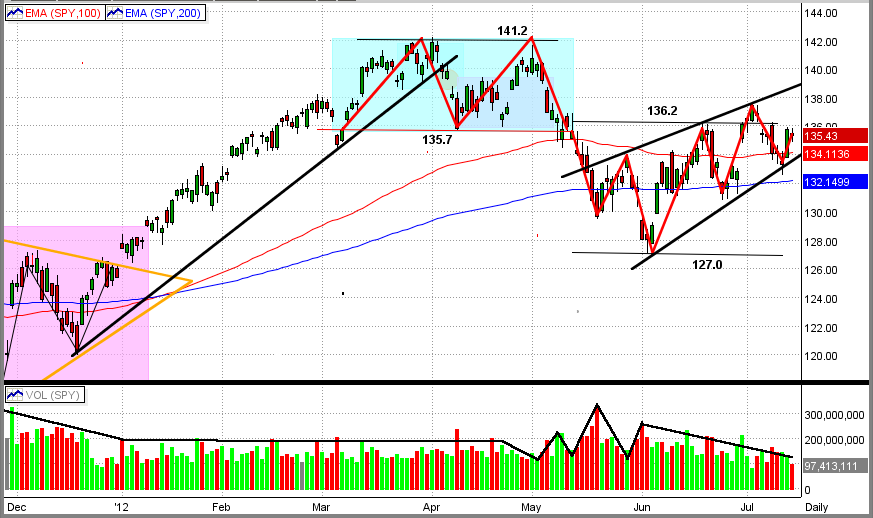
<<< Previous post - 7/2/12 >>>
|
As you look at the two graphs below, you will see either of:
1) Another Trading Range as in Chart #1, or
2) A New Up-Channel as in Chart #2.
Chart #1 - Another trading range, with up-side resistance at 136.2 and downside support at 127.0
- If the SPY breaks thru 136.2 to the upside, we should have a rally
- But, if the SPY fails to break up above 136.2 over the next few days, the SPY will most likely
fall back to 127.0
Chart #1

Chart #2 - An Up-Channel, with higher highs and higher lows
- This market is definitely trending up, so the question really is: "Is this truly a new up-channel?"
- The SPY has been bouncing between 127 and 136 for all of 2012, so it's time the market finds a new trend
- The chart below seems to be indicating that its new direction will be up, but it could easily continue sideways
- So, let's let MIPS tell us what to do and when.
Chart #2
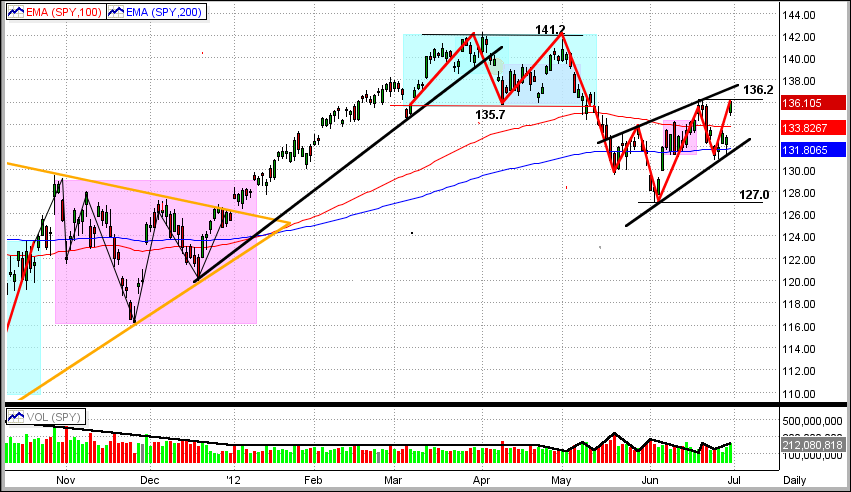
|
Wednesday, June 06 2012
Well, can we now answer the question from our previous email, "Is This a Correction or a Bear Trap" ?
- When we look at the last few days on the graph immediately below, it sure looks like the SPY will run up from here,
officially making the downside break on 6/1/12 a "Bear Trap".
- Not only did the SPY turn back to the upside, it kind of peeked its head above its 200-day EMA (blue line) and its
short-term trendline (black line).
- On the negative side, the volume during this very short-term "rally" has been weak and is declining as the market
moves up.
- The next strong resistance is the SPY 100-day EMA at $134 (red line)
However, none of the problems that sent the market down recently are even close to being "fixed". And, none of the MIPS models (except the very long-term MIPS1/VLF model) are convinced that the market action over the last few days constitutes a "new intermediate up-trend" yet, and they stand by their "Short" signals (at least for now).
And, of course, only time will tell which direction the market will move from here, but it should only take a short amount of time to do so. Needless to say, the next few days are critical.
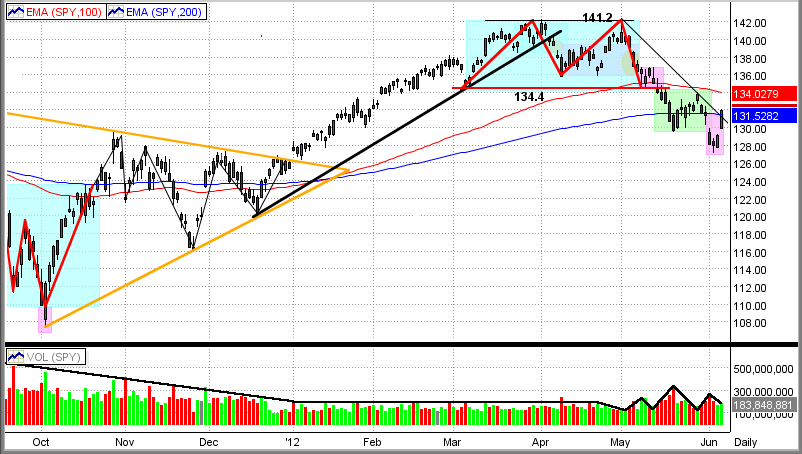
Monday, June 04 2012
By all measures of technical analysis, the recent market action and volume (or lack thereof when the market moved up) would indicate a correction (or worse).
See the graph immediately below and scan the previous emails.
From the 1st graph, you will see that the SPY has:
- broken its most recent intermediate-term trendle,
- fallen below the neckline of a double-top pattern (blue box)
- fallen below both its 100-day EMA and 200-day EMA (red line and blue line)
- broken thru the bottom of its most recent trading pattern (green box)
And, the trading volume of the SPY has been decreasing in up moves and increasing in down moves.
That in itself is usually strong evidence of a market downdraft (correction or worse). Taken together with the terrible unemployment rate and very slow job creation in the US, the slowdown in the Chinese economy, and a possible meltdown in Europe, and it could become a recipe for disaster. That is what the graph below is trying to tell us.
But, it could also be displaying a Bear Trap signal. Look at the two drops in the SPY shown in the orange circles, one in early Oct'11 and the other on Friday of last week. On 10/04/12, the SPY's drop thru the bottom of a sideways trading pattern turned out to be a one-day key reversal, and this Bear Trap was followed by a 30% gain in the SPY.
So, could the SPY's drop on 6/01/12 possibly be a similar Bear Trap and be followed by another strong intermediate-term uptrend ? The market action in the next 2-3 days should be indicative of what the next major move in the market will be. [Keep in mind, however, that it would not be abnormal for the SPY to move up on Monday following its 2.5% drop on Friday (this has kind of been the norm in the last few years of high volatility).]
Whew, enough guessing. Let's follow MIPS and let it guide the way for us.
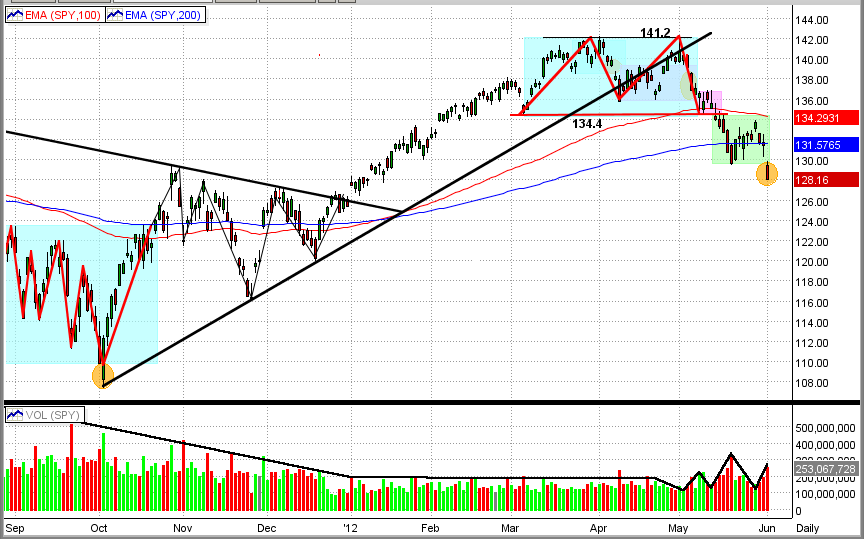
|